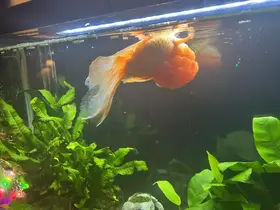Swim Bladder
When a fish is unable to swim correctly, appears to be tilting when swimming, or is unable to even sink into the water (appears to be bloated resulting in it almost floating at the surface of the water) it is a strong sign that your fish has swim bladder disease. In many cases, this can appear to look like the fish is either unable to control its movements, or the fish may be dead and just floating through the current inside of your aquarium. Although it is commonly labeled as a disease, swim bladder disease is more of a symptom due to either an issue affecting the fish's swim bladder organ or other less obvious factors.
Identification
Swim bladder disease is most commonly known for making fish lose control of their swim bladder organ, which in turn allows them to sink and float throughout the water column. When something goes wrong with this organ, it can cause the fish to lose control of its ability to swim correctly either temporarily or permanently. In a variety of cases due to breeding deformations into the fish, many fish breeds such as fancy goldfish and blood parrots are bred to have an enlarged swim bladder organ. Due to this organ being enlarged, it can result in the fish losing complete control of being able to swim if they are fed incorrectly, constipated, or if they get any physical injuries inside of their setup.
Pathology
A majority of fish species already carry this bacterium either within their bodies or through the food that they naturally eat. When the fish has no other weaknesses in their immune system due to good conditions and a proper diet, the bacteria will stay dormant. However, once the fish's immune system becomes weak the bacteria will reactivate and can start to infect not only the fish but any other fish that comes in contact with the infected fish. In a majority of environments, this bacterium is spread from fish by bullying the weaker fish or attempting to eat its body once the infected fish dies, thereby now infected infecting the healthy fish and turning them into a carrier of this bacteria.
Sadly, due to the way that this bacterium can stay alive in hosts that do not have a weak immune system, make sure to keep water conditions perfect, make sure to not overstock the setup with too many fish, and also have the correct water temperature set is very important. Many have noted that the most common carriers of this disease are labyrinth fish such as Bettas or Gourami.
Treatment and Medication
Since there are various reasons why a fish's swim bladder can be working either incorrectly or not working at all, we must look at each of the individual cases that commonly affect this organ. Treatment can vary from case by case to situation, and many times the swim bladder will appear to have fixed itself almost on its own if given enough time.
If the fish is a newborn fry and is unable to swim correctly, the issue is instead resulting in bad genes or an issue when they were being developed inside of their mother. Sadly, nothing can be done for these cases since it is impossible to give them better genes or undo the damage that was done when they were being developed. Making sure not to move the fry from one setup to another (as water parameters can vary greatly from one tank to another even if the water source is the same) can reduce any damage that is gone through developmental issues. Since fry are technically growing into their adult form for up to the first few years (depending on the fish species), we must make sure we provide them with excellent conditions.
When feeding any fish species it is highly important to make sure that the foot is placed below the water's surface if the fish are attempting to get the food from the surface of the water they can accidentally suck in air which will cause them to bloat. This bloat is temporary but can result in them losing control of their swim bladder organ for a few hours. The same can happen when a fish overeats (or is being overfed) resulting in too much food inside of their body and making their swim bladder organ highly ineffective temporarily. Some common foods that will result in a fish having trouble with their swim bladder can include even algae wafers since although they may be at the bottom of the setup they still normally enlarge over time when exposed to water (depending on the brand). If a fish eats some before it is fully enlarged, it will cause some excess bloat inside of its body. A common tip is to make sure that you let the fish fully digest all of their food before giving feeding them the next day. If you see any of the fish with a stomach that is larger than normal, have them fast that day to avoid them becoming constipated with food. Keep in mind that fish can survive up to a few weeks without any food if they are been properly cared for in the previous few weeks beforehand.
Less common issues can be related to bacterial infections, parasites that are inside of their body, worms of various kinds living inside of their organs, and physical damage if the fish is large enough to bite (or body slam) into another fish. If the fish is infected it is key to make sure that you find the symptoms that they appear to have and treat them as soon as possible. If a fish is injured at all, try making sure to remove any rough decorations, fish, or sometimes even equipment that could lead the fish to hurt itself. Using medicine can improve the speed at which the fish will heal and therefore have their swim bladder back in working order.


